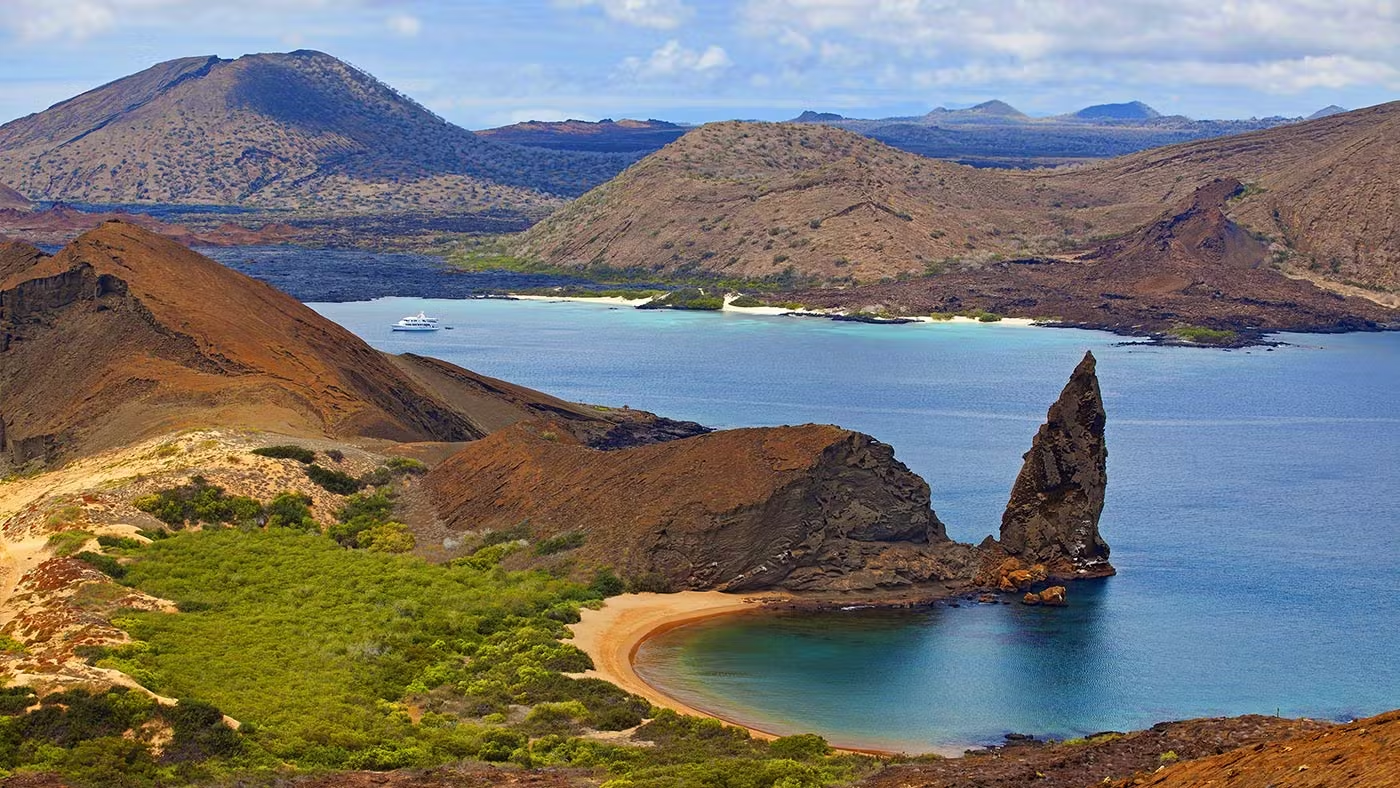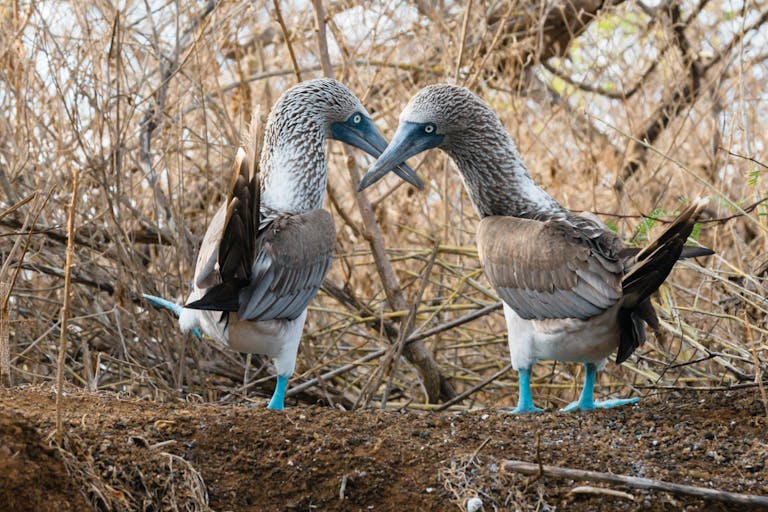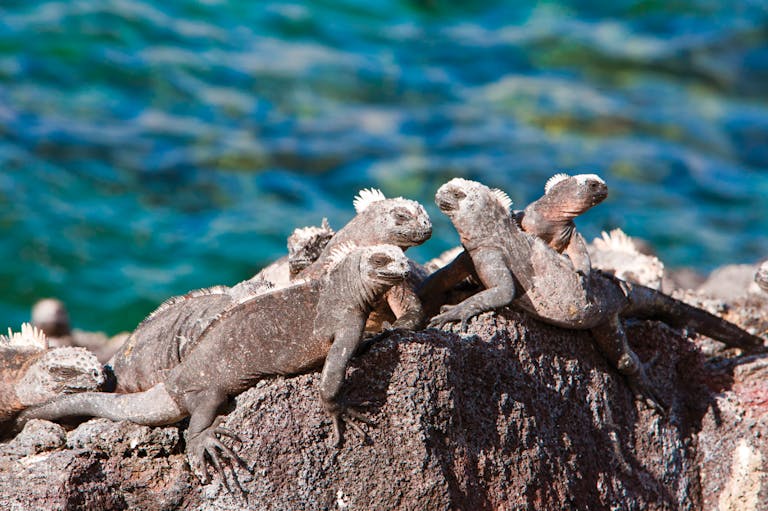Nestled 600 miles off Ecuador’s coast in the Pacific Ocean, the Galapagos Islands beckon adventurers and nature enthusiasts worldwide.
The Galapagos Islands offer a glimpse into the world before human existence, showcasing an impressive diversity of flora and fauna, breathtaking geological formations, pristine waters, and spectacular beaches.
MT Sobek offers great hiking and trekking trips to the Galapagos islands, with abundant wildlife sightings for tourists!
In 2024, a Galapagos Adventure Tour is gaining popularity among travelers who enjoy adventure, hiking, or wildlife viewing!
Thinking about taking a trip with your family? The Galapagos Islands are a great choice, offering a 3D educational and fun experience for children. Look at the top 5 interesting facts about the Galapagos Islands.
Overview
- How Many Islands Make Up The Galapagos?
- Who Owns the Galapagos Islands?
- The Majority of the Galapagos is a National Park
- The First Tourists Came to the Galapagos in 1934
- When is the Best Time to Visit the Galapagos Islands?
1. How Many Islands Make Up The Galapagos?
The Galapagos is a known archipelago, which is a chain or cluster of islands. And while the number of actual islands or islets is always changing because of volcanic activity the number of islands has been static for thousands of years at around 20. But that doesn’t mean that all of these islands are inhabitable or significant.
Of the 20 or so islands within the Galapagos, only 18 of them are considered major islands, which means each of these islands are land areas of at least 1 square kilometer size!
Major Islands:
| Baltra | Genovesa | Rabida |
| Bartolome | Isabela | San Cristobal |
| Darwin | Marchena | Santa Cruz |
| Espanola | North Seymour Island | Santa Fe |
| Fernandina | Pinzon | Santiago |
| Floreana | Pinta | Wolf |
Even though there are upwards of 18 major islands that make up the Galapagos, only two of them cater to inbound air travel, San Cristobal and Baltra. To visit neighboring Galapagos islands, the main mode of transportation is by boat, however there is an airport on Puerto Villamil (Isabela) that caters to local flights.
If you really want to experience all that the Galapagos Islands have to offer, we highly suggest booking a small cruise adventure that will take you through the islands. It’s the best way to explore the incredible environment as well as the amazing wildlife. The best time to visit the Galapagos Islands is anytime!
However, if you’re not looking to spend your vacation on a boat, there are plenty of incredible land-based programs that will allow you to experience the islands as well.
2. Who Owns the Galapagos Islands?
The Galapagos Islands are a part of the neighboring country of Ecuador, located in South America. A Spanish explorer named Fray Tomas de Berlanga initially uncovered the Galapagos, emerging from the Pacific Ocean approximately 600 miles away from Ecuador’s coast, in 1535.
Fray Tomas de Berlanga discovered the islands as he sailed to Peru, his target country, but the winds carried his ships off course when they could no longer support their travels. He would land on the Galapagos Islands on March 10, 1535.
The Spanish would eventually give up on the islands due to the harsh landscape and isolation from other land masses. Later, in 1832, Ecuador sent a crew to survey the land and eventually annexed the land in 1832 naming them the Archipelago of Ecuador.
The name “Galapagos” comes from the original Spanish empire that dubbed the island “Insulae de los Galopegos” (Islands of the Tortoises). And even though the official name today is “Archipielago de Colon” named after Christopher Columbus and his discovery of the Americas, the islands are more commonly known as “Galapagos Islands”.
For centuries, coming to the Galapagos was a risky business: currents and winds made the navigation easy to the Galapagos and the lack of fresh water and the great difficulty to return to the mainland kept people away from the islands. Thankfully, it is much easier to reach the Galapagos islands thanks to more modern methods of travel technology.
3. The Majority of the Galapagos is a National Park
In an effort to conserve and protect the ecosystems within the islands, in 1959, for the 100th anniversary of the appearance of “On the Origin of Species”, the Ecuadorian government declared 97% of land a National Park. Following that, UNESCO named the surrounding waters a UNESCO Biosphere Reserve in 1998. The Marine reserve is one of the largest marine parks in the world covering 51,000 sq. miles, and even today the Ecuadorian government protects the island, preserving the natural landscape as well as the wildlife that call the islands home.
One increasingly big issue is that invasive plant species and animals, introduced to the Galápagos Islands, threaten the environment. Outside of humans themselves, these plants and animals overrun the native plants and animals and cause issues. An increasingly bigger issue is that many of the introduced animals have begun to cause problems with the native species, and since there are no natural predators for these new animals, it’s hard to keep their population in check. And the same goes for the plant life.
As of today there are officially 500 native plant species on the islands, compared to over 700 introduced species. As more people visit the Galapagos islands, invasive species become a problem, highlighting the need to protect these lands.
Until now, people consider these Galapagos islands as the best conserved marine life globally.
Because of the large numbers in tourism, and money, to the islands, conservation efforts have increased throughout the years.
So while tourists and locals do bring with them their own set of problems for the land and animals, in many ways the islands are better now than they were 40 years ago.
Is the Galapagos Islands on your bucket list? -> Join MT Sobek’s 11-day Galapagos wildlife cruise to the beautiful Western Islands!
4. The First Tourists Came to the Galapagos in 1934
It may sound like tourism on the Galapagos islands has been around for centuries, but in fact, the first tourists to the islands visited in 1934—less than 100 years ago.
The first tourist visitors to the Galapagos islands began arriving for day trips as part of their cruise experiences. In those days, prior to air travel, to access the islands you would have to charter a boat or use a private vessel.
One feat is that MT Sobek was the second US company to begin trips to the islands in 1970, which we continue to offer trips to this day.
Since then, tourism to the islands has been booming with over 200,000 people visiting the island each year, over the course of the last few years. But when compared to other major tourist destinations, like Hawaii (which accommodates up to 10,000,000 visitors per year), the Galapagos still maintains that intimate and nature-centric island feel.
To meet the demand of trips to the Galapagos islands and preserve the landscape and environment of the islands, the islands see limited number of tourists every year and conservation efforts have been very successful and active over the years.
Tourism on the island is not going to slow down anytime soon. The Galapagos islands have become an extremely popular destination over the last few years and are expected to continue to thriving even beyond 2023.
Book Now! -> Request Catalog
5. When is the Best Time to Visit the Galápagos National park?
The truth is, any time of year is a great time to visit the Galapagos.
If you’re looking to book a scenic trip to the Galapagos islands, you won’t have to worry about the weather or temperature, or have any concerns about daylight. Since the islands are located on the equator, partly in the northern hemisphere and partly in the southern, the temperature remains fairly consistent—ranging from high 70’s to the mid 80’s.
From December to May, the islands experience the “wet season” with the most rainfall. However, the rain doesn’t stay for long and moves away quickly. So you may experience quick bursts of heavy rain for a short amount of time, and then it’s over.
The dry season runs from June to November which will bring in slightly cooler temperatures and more cloud cover, with a chance of a slight sprinkle here and there.
Yet no matter what time of year you choose to visit, you are sure to see some incredible wildlife.
For those seeking to increase your chances of seeing a particular animal during your stay, there are certain months that are better than others for many of the species.
January is when you’ll find the adult male marine iguanas on Espanola’s Island become brightly colored to help attract mates. While the sea turtles begin to dig holes in the sand to lay their eggs, you may also witness the hatching of some of the giant tortoise eggs.
In February the greater flamingos begin their nesting on Floreana Island, while the penguins migrate away from Bartholome Island towards the cooler waters of Isabella and Fernandina. And while the Nazca boobies are ending their nesting season, the marine iguanas on Santa Cruz island are just beginning theirs.
March brings the waved albatross’ to the islands with their incredible black wings and the frigate birds begin their mating season on San Cristobal and Genovesa islands. This is also a great time for snorkeling as the water temperatures usually hover in the upper 70’s.
In April the sea turtles, marine iguanas and land iguanas begin their nesting, while the waved albatrosses begin their courtship.
And May is when the waved albatross lay their eggs on Espanola Island. Blue-footed boobies stamp back and forth across the islands with their big blue flipper feet as they begin their courtship and the Galapagos sea lions begin their mating season, which is quite a sight to see.
June is probably your best chance of getting a glimpse of the whale sharks and humpback whales off the island coasts. The male frigate birds also being their courtship by inflating their red pouches, which is beautiful to watch.
July starts the beginning of the sea lion and lava lizard mating season. The greater flamingos being their courtship “dance”, and whale sharks can be spotted near Darwin and Wolf islands.
In August, the sea lions begin to give birth, which is absolutely incredible, while the frigate birds’ eggs begin to hatch revealing their fuzzy little chicks. The giant tortoises make their way back into the highlands after laying their eggs and the courtship of the Galapagos hawks begins on Santiago and Espanola islands.
September is a great time to the baby sea lions migrating around the islands. The Galapagos penguins will begin their courtship on Bartolome Island and continue through December. And near the northwest islands, humpback wales and whale sharks can often be seen migrating.
As October nears, you’ll begin to catch a glimpse of the blue-footed booby chicks on Espanola and Isabella islands. You’ll also witness lava herons beginning to nest, while the Galapagos fur sea lions begin their mating season.
November provides another great opportunity to see whale sharks in the northwest of the islands, as well as witnessing the Galapagos sea lion pups being born.
As the year ends, and December arrives, the baby giant tortoises being to hatch, while the young waved albatross begin to migrate away from the islands. Land iguanas, sea lions and fur sea lions begin mating, and it’s a great time to observe land birds such as finches and doves.
The Galapagos Islands have quickly become a popular destination to visit, and for good reason. Between the incredible weather, and amazing plants and wildlife, it has something for almost everyone. And no matter what time of year you decide to visit, the sights will always amaze you.
See the Galápagos Islands For Yourself! Book a Galápagos Adventure.
This is a multi-adventure destination that the whole family can enjoy and here at MT Sobek we’ve got a variety of great adventure trips that cater to all people. Visit our Galapagos Islands Adventures page for more information about the islands, the experiences you can have, and the amazing cruising adventures that MT Sobek offers.
Book Now! -> Request Catalog








